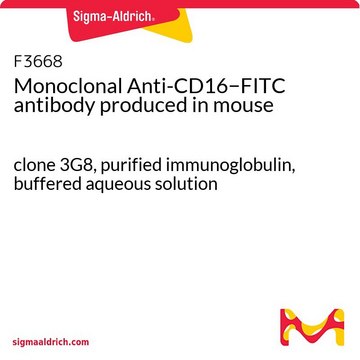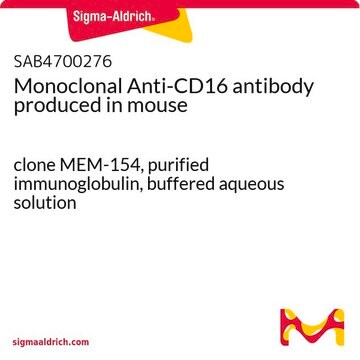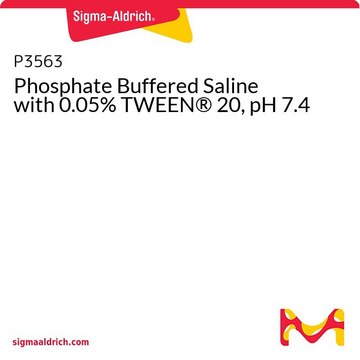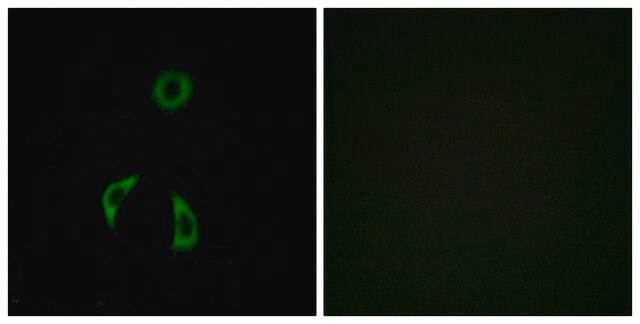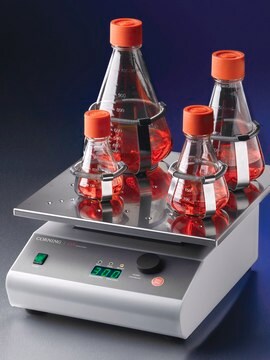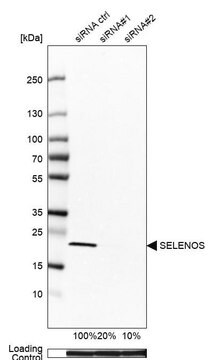SAB4700269
Monoclonal Anti-CD16 antibody produced in mouse
clone LNK16, purified immunoglobulin, buffered aqueous solution
Synonym(s):
Anti-FCGR3A, Anti-FcγRIII
Sign Into View Organizational & Contract Pricing
All Photos(1)
About This Item
UNSPSC Code:
12352203
NACRES:
NA.41
Recommended Products
biological source
mouse
Quality Level
conjugate
unconjugated
antibody form
purified immunoglobulin
antibody product type
primary antibodies
clone
LNK16, monoclonal
form
buffered aqueous solution
species reactivity
nonhuman primates, human
concentration
1 mg/mL
technique(s)
flow cytometry: suitable
isotype
IgG1
NCBI accession no.
UniProt accession no.
shipped in
wet ice
storage temp.
2-8°C
target post-translational modification
unmodified
Gene Information
human ... FCGR3A(2214)
Related Categories
General description
The antibody LNK16 reacts with CD16, a low affinity receptor for aggregated IgG (FcgammaRIII antigen). CD16 exists in two different isoforms: CD16a (FcgammaRIIIA; 50-65 kDa; expressed on NK-cells, monocytes and macrophages) and CD16b (FcgammaRIIIB; 48 kDa; mainly expressed on neutrophils).
Immunogen
Normal human peripheral blood granulocytes
Application
The reagent is designed for Flow Cytometry analysis. Suggested working dilution for Flow Cytometry is 2 μg/mL of sample. Indicated dilution is recommended starting point for use of this product. Working concentrations should be determined by the investigator.
Features and Benefits
Evaluate our antibodies with complete peace of mind. If the antibody does not perform in your application, we will issue a full credit or replacement antibody. Learn more.
Physical form
Solution in Tris buffered saline, pH 8.0, with 15 mM sodium azide.
Disclaimer
Unless otherwise stated in our catalog or other company documentation accompanying the product(s), our products are intended for research use only and are not to be used for any other purpose, which includes but is not limited to, unauthorized commercial uses, in vitro diagnostic uses, ex vivo or in vivo therapeutic uses or any type of consumption or application to humans or animals.
Not finding the right product?
Try our Product Selector Tool.
Storage Class Code
10 - Combustible liquids
WGK
WGK 1
Flash Point(F)
Not applicable
Flash Point(C)
Not applicable
Choose from one of the most recent versions:
Already Own This Product?
Find documentation for the products that you have recently purchased in the Document Library.
Giovanni F Torelli et al.
Haematologica, 99(7), 1248-1254 (2014-03-25)
In this study, we aimed to investigate the pathways of recognition of acute lymphoblastic leukemia blasts by natural killer cells and to verify whether differences in natural killer cell activating receptor ligand expression among groups defined by age of patients
Eri Shimura et al.
Biochemical and biophysical research communications, 453(1), 1-6 (2014-09-11)
IL-17RA is a shared receptor subunit for several cytokines of the IL-17 family, including IL-17A, IL-17C, IL-17E (also called IL-25) and IL-17F. It has been shown that mice deficient in IL-17RA are more susceptible to sepsis than wild-type mice, suggesting
Megan M Tu et al.
Cancer research, 74(14), 3684-3694 (2014-05-08)
According to the missing-self hypothesis, natural killer (NK) cells survey for target cells that lack MHC-I molecules. The Ly49 receptor family recognizes loss of MHC-I and is critical for educating NK cells, conferring the ability to eliminate transformed or infected
Britnie R James et al.
Cancer immunology, immunotherapy : CII, 63(11), 1213-1227 (2014-08-22)
Tumor progression occurs through the modulation of a number of physiological parameters, including the development of immunosuppressive mechanisms to prevent immune detection and response. Among these immune evasion mechanisms, the mobilization of myeloid-derived suppressor cells (MDSC) is a major contributor
Allen Y Chung et al.
Cancer research, 74(19), 5377-5385 (2014-09-18)
Immune dysregulation drives the pathogenesis of chronic inflammatory, autoimmune, and dysplastic disorders. While often intended to address localized pathology, most immune modulatory therapies are administered systemically and carry inherent risk of multiorgan toxicities. Here, we demonstrate, in a murine model
Our team of scientists has experience in all areas of research including Life Science, Material Science, Chemical Synthesis, Chromatography, Analytical and many others.
Contact Technical Service